
65
International Journal of Management (IJM)
Volume 9, Issue 5, September–October 2018, pp. 65–74, Article ID: IJM_09_05_008
Available online at
http://www.iaeme.com/ijm/issues.asp?JType=IJM&VType=9&IType=5
Journal Impact Factor (2016): 8.1920 (Calculated by GISI) www.jifactor.com
ISSN Print: 0976-6502 and ISSN Online: 0976-6510
© IAEME Publication
TRENDS IN THE ONLINE SHOPPING
PATTERNS OF CUSTOMERS IN KATTAKADA
PANCHAYATH OF THIRUVANANTHAPURAM
DISTRICT
Sreejith R K
Assistant Professor of Management Department,
Vigyaan College of Applied Sciences, Kattakada PO, Thiruvananthapuram, Kerala, India
ABSTRACT
Online shopping is making rapid strides in our society in the recent times. it has
been common phenomenon in the urban areas of the country while not making proper
inroads in the rural areas. However, this study conducted in a typical semi-urban area
in Kerala state of India has proven that online shopping has penetrated the semi-
urban / rural community also. a majority of the respondents of Kattakada Panchayat
of Thiruvananthapuram district of Kerala state, irrespective of gender, age or
education, has shopped online frequently. at the same time, a major portion of the
online shoppers have also faced problems during online shopping, delivery of the
wrong product or damaged product being the most common problem. It has been
shown that the respondents of the study have favourable attitude towards online
shopping. Hence, if the online shopping companies pay more attention to solving the
problems faced by the customers during online shopping, they can reach more number
of people even in the remote areas of the country.
Key words: Digital Marketing, E-Commerce, Google, Trends, Online shopping,
Customers.
Cite this Article: Sreejith R K, Trends in the Online Shopping Patterns of Customers
in Kattakada Panchayath of Thiruvananthapuram District. International Journal of
Management, 9 (5), 2018, pp. 65–74.
http://www.iaeme.com/IJM/issues.asp?JType=IJM&VType=9&IType=5
1. INTRODUCTION
Online shopping as defined by Master card Worldwide Insights (2008) is the process of
purchasing goods and services from merchants who sell over the internet. Generally, it is also
known as internet buying, electronic shopping, online purchasing or internet shopping. Kim
(2004) further defined internet shopping as examining, searching for, browsing for or looking
at a product to get more information with the possible intention of purchase on the Internet.
By looking at other perspective, Chiu et al (2009) considered online shopping as an exchange
of time, effort and money for receiving products or services. Retailers see it as internet/online

Trends in the Online Shopping Patterns of Customers in Kattakada Panchayath of
Thiruvananthapuram District
http://www.iaeme.com/IJM/index.asp 66 editor@iaeme.com
retailing, e-commerce or e-store/online store, which refers to “the sale of retail goods via
online channels, valued at retail selling price” (Data monitor, 2009). As such, there are
various ways of defining online shopping and it may depend on which perspective we are
looking at or interested in.
Online shopping is no doubt the future trend in India. Online shopping on sectors such as
fashion and accessories, electronic/electrical goods and books are growing in the metro cities
and urban areas of India at a very rapid rate. However, little is known about the acceptance of
online shopping and problems faced by customers in other parts of the country. The purpose
of this study is to identify the extent of influence of online shopping on the population of
Kattakada Panchayat situated on the outskirts of Thiruvananthapuram, the capital city of
Kerala.
Online shopping is easy, quick and literally a click away. But it isn‟t that simple and has
many issues. While shopping online, consumers are faced by many challenges, which are not
necessarily limited to fake products or hidden costs alone. Customers like to shop at websites
that offer them convenience, are easy to browse through, aesthetically appealing and provide
relevant information. When the website is not optimized right, it leads to the case of
abandoned carts, order cancellations or returns. Studies show that while 43% of the purchases
are influenced by online information, online sales are only 9% of in-store sales.
2. ONLINE SHOPPING PROBLEMS THAT CUSTOMERS FACE AND
POSSIBLE SOLUTIONS
2.1. Product Quality
This is the most common problem faced by customers who shop online regularly. The quality
of the product is often not up to the mark with what is presented in the pictures. With the
competition growing in the e-commerce industry, as many websites become a marketplace for
sellers to sell their products, and the issue of fraudulent sellers is increasing. The checks on
registration are poor and selling poor-quality in the name of brands is becoming increasingly
common. Even worse, quality-checks have become so rare with the magnitude of online sales
which is soaring high.
2.2. Logistics are a mess
This is another common issue faced in online shopping. Barring a few websites, delivery and
logistics is a major issue. Websites are becoming so casual about the delivery quality of
products. So many times, either the package is lost or damaged while in transit. Customers are
facing a troubled time with the tracking systems which do not accurately locate the product.
Often customers choose same-day-delivery by paying a few extra bucks only to get their
product delivered.
Many of these companies do not follow the stipulated time limit, leaving consumers
confused as the products come in too late. The issue is the same with returns. You place an
order for the returns to be picked up and there is no response. They will send the delivery guy
when they seem fit, almost never according to the promised time. Sometimes customers
receive the product after the need is over.
Possible Solution: Since logistics has become very complex, it is mandatory for ecommerce
business owners to keep tabs on it. An ecommerce platform with inventory management
solutions can give an idea to the owner about the stock status and thus, product deliveries can
be managed much more accurately

Sreejith R K
http://www.iaeme.com/IJM/index.asp 67 editor@iaeme.com
2.3. Delivery Time is Not Clear
So many times, the delivery time is not clearly stated in the order process. More often than
not, consumers do not know when the product will be delivered. Consumers buy a product
and the ecommerce businesses do not even state the time of delivery. Many a times, these
orders take more time than expected to be delivered.
It‟s important for buyers to have realistic expectations and know when they can expect
their orders. It is important for people to know when their product is arriving so that they can
plan their day accordingly. Customers often complain that the delivery boys do not even call
them before arriving to deliver the product. The best thing is to check with the website about
the estimated time of arrival of a certain product before you place the order.
Possible Solution: Send Message to the customer when the order is shipped and then when it
is expected to be delivered so that the customer is prepared to receive it.
2.4. Payment Preferences are Limited
This is another common problem. A lot of times, consumers do not know how to make the
payment if the debit cards they use are not available as an option. More so, customers are
often stuck with the payment options when Cash On Delivery is not available. With online
frauds picking up steam, most customers prefer paying cash on delivery as they are skeptical
about sharing their card details. This is a common complaint by many customers these days.
They do not have many payment methods that they can trust
Possible Solution: An e-security seal like TRUSTe on the website can help earn the trust of
the consumer opting for e-payments on the website. Further, use of e-payments offers
convenience to the buyers and hence leads to increase in sales.
2.5. Payment Confirmation Missing
Another challenge is to find a payment gateway that is smooth. Sometimes when the
customers are directed to the payment page, their money is deducted and suddenly, the page
shuts off without any notice to the consumer. And that‟s when the customer is in a fix. Then
chasing the company for a refund is a different challenge altogether. With bulk sales
happening at the same time, sometimes it‟s a ecommerce specialist to ensure that the payment
page is working fine.
Also sometimes the website asks too many secret questions or too much info before the
customer can make the payment. This too can increase the perceived inconvenience during
the purchase and leads to an abandoned cart.
Possible Solution: A quick fix is to email payment confirmation to the customer. If a
customer gets an email confirming the order, they are not worried about the outcome. They
know they are paying for an order that has been placed successfully. Also, keep the payment
process simple and easy to execute without including too many stages.
2.6. The Trouble with Hidden Costs
This is another common issue customers face even with leading e-commerce development
companies. Online marketplaces do not tell customers the hidden costs on so many things. For
instance, the customer is lured into buying something that says is cost at a certain price.
Within minutes, they are paying a lot more to get the product delivered, tax charges,
additional shipping, etc. This eventually leads the customer to pay a lot more than he or she
had expected.
Possible Solution: A simple solution is to keep the charges so apparent that the customers do
not feel cheated and buy the products of their interest for sure.

Trends in the Online Shopping Patterns of Customers in Kattakada Panchayath of
Thiruvananthapuram District
http://www.iaeme.com/IJM/index.asp 68 editor@iaeme.com
2.7. Unclear Website Policies
Many shopping websites do not even have clear and concise website policies for return and
refund. Consumers get confused due to vague stipulations about a refund and return. When
the policies section is not defined properly, sellers reject a consumer‟s claim to return or get a
refund. This is among the biggest challenges that many customers face online. A lot of these
websites have no clear outline on the warranty and guarantee of products. A buyer can take
this to consumer court in case the demands are not met with.
Possible Solution: Localization is the key as the online businesses go global. The website
policies and other information should be available in different languages for people to
understand them better and clearly.
2.8. Problem of Plenty
The online world provides too many options and it can be overwhelming for the customer to
make a choice. The absence of support that most customers are used to in the in-store
experience is missing and this can chicken out them of a purchase decision.
Possible Solution: Give proper product specs in the same format for all products so it is easy
to compare them. Instead of overloading the customer with information, give minimal but
useful information. A shopping comparison tool can help buyers simplify their purchases
decisions. Also, a live chat option to offer queries always is comforting for buyers to make
that final click.
2.9. Complicated Navigation
Does your website resemble a maze of where the visitor feels lost? It‟s tempting to opt for
complex looking website structures and designs and they may also hook in many curious
customers; but this may not be a great idea to build long-term customer base. Most visitors
get frustrated with this complex monstrous website and bounce off.
Possible Solution: Keep the website structure simple and provide easy navigation tools to the
customers. Magento ecommerce developers often use heat-map tools to analyze where the
customers spend maximum time and where do they bounce off. This analysis can help them
remove the clutter and help the visitors go to the information/page they want smoothly.
Do away with long forms. Also, reduce the number of clicks required to complete a purchase.
2.10. Boring Interfaces
While overwhelming site structures can be a bummer, websites with insipid interfaces don‟t
get much done either. It‟s hard to get attention of the customers, so make sure you get it right
at the first go.
Shoppers are an impatient lot. Get their attention with attractive website designs that
allure visitors and give them an enjoyable experience both on desktops and other handheld
devices like mobiles, tabs etc
Possible Solution: Make sure your web pages don‟t take too long to load. Give interactive
product guides to keep visitors entertained and engaged at the same time.
3. STATEMENT OF PROBLEM
The purpose of this study was to identify the extent of acceptability of online shopping by the
local people of a typical middle class town area in the country and the awareness among them
of the possible risks associated with it, while mainly concentrating on the problems faced by
them while shopping online. Online sites record important customer data like name, phone
number, address, and bank details. If these sites don't implement stringent cyber security

Sreejith R K
http://www.iaeme.com/IJM/index.asp 69 editor@iaeme.com
measures, your data is at risk of falling into the wrong hands who can then wreak havoc on
your bank account. Nearly half of customers who bought goods online over the past two years
had a problem with their purchase, new research has revealed. These range from being high
Price, extra delivery charge and low quality or incurring an unexpected fee to the items
arriving faulty or damaged. Extended service packages from retailer or third parties usually
are overpriced and generally are not of good value. Since the online of the study area are well
educated, they know the importance of the problems faced while shopping online and the
ways to overcome it. Hence, it was decided to conduct a study on the topic “Trends in the
online shopping patterns of Customers in Kattakada Panchayat of Thiruvananthapuram
District” for project work.
4. SCOPE OF THE STUDY
This study mainly focus on primary data, which data collected from the online purchasing
customers in Kattakada Panchayat of Thiruvananthapuram District only. The study covers
opinion of customer about online shopping and problems faced by the customers related to
online shopping.
5. OBJECTIVES
The main objectives of the study are as follows:
To identify the socio economic status of the customers doing online shopping.
To analysis the factors influencing the customers about online shopping.
To analysis the problems faced by the customer while shopping online.
To identify suitable methods for solving their problems based on the findings
6. METHODOLOGY
6.1. Primary Data
The primary data were collected from the field directly with the help of an interview schedule.
Sample size
The data were collected from 150 sample respondents at Kattakada Panchayat selected
through convenience sampling.
6.2. Secondary Data
Secondary data are those which have been collected by someone else and which already have
been passed through statistical process. The secondary data has been collected from various
books, journals, magazines.
6.3. Tools for Analysis
Statistical tools such as table, percentage, Standard deviation method were used to analyse the
data collected and to arrive the conclusion.
7. LIMITATIONS:
1) The study is confined to the population of Kattakada Panchayat of Thiruvananthapuram
District only.
2) The data collected for the research is based mainly on the primary data given by the
respondents. There is chance for personal bias which may affect accuracy.
3) The study was conducted within a limited time period which might not have been sufficient
to the identify the full extent of the problems faced by online shoppers.

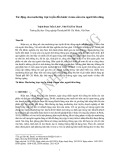
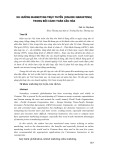

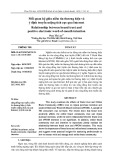
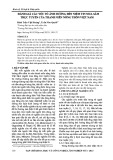
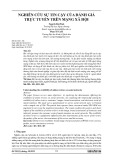
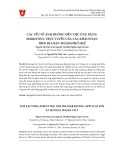
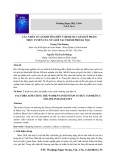
![Yếu tố ảnh hưởng đến niềm tin vào mua sắm online [mới nhất]](https://cdn.tailieu.vn/images/document/thumbnail/2021/20211204/vimichaeldell/135x160/4661638580821.jpg)
















